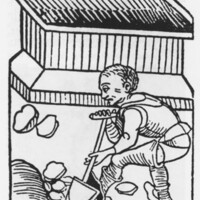Armenian Bole
Dublin Core
Title
Subject
Description
At the end of the fourteenth century and start of the fifteenth century, Armenian bole as a recommended base for water gilding was mentioned for the first time by Johannes Archerius and Cennino Cennini. The red color of the gilding base in many fourteenth- and fifteenth-century Italian manuscripts is likely Armenian bole or a similar red earth. The usage of Armenian bole reached its peak between the end of the fourteenth century and the eighteenth century, both in the western tradition as well as the east.
As its name suggests, Armenian bole comes from Armenia and surrounding areas of the Mediterranean. It was imported into Europe particularly for its use in gilding but also for its medicinal use. Increased importation of Armenian bole in the fourteenth and fifteenth centuries has been attributed to a number of reasons. One is the spread of water gilding techniques and their practice throughout Europe. Another explanation is increased demand for its believed healing effects against the plague during the epidemics of the time.
As the mining of similar clays spread throughout regions of Europe in the sixteenth century, the import of Mediterranean boles gradually decreased in the seventeenth and eighteenth centuries. Emanuel Mendes da Costa mentioned that it was “dug in Armenia, but is seldom or never to be found genuine in our shops” in 1757. The term “bole” was confused or interchanged with terms like “red earth” or “red ochre,” and other red clays were sold as or substituted for Armenian bole. As such, the exact composition of Armenian bole used by painters was (and to some degree still is) unclear.
Source
Fol. 6r - “For laying down and seating burnished gold and giving red or green or blue”
…Next take fine boli armeni* & sanguine, as much of one as of the other, also lamb tallow the size of a bean or a pea depending on the quantity of bole, and a little willow charcoal, or as much as the tallow, & half a walnut shell full of half-burned saffron. Some put in a little candy sugar. Grind all together with water, & apply it without gum or glue, & let it dry, & rub the place that you want to gild with a piece of white cloth to better smooth it, & when the rubbed place is a little shiny, it is a sign that the gold will be carried well…
Fol. 7v - “Against gonorrhea”
Aquæ fabrorum antiquæ lb i., boli Armeniæ in tel tenuissimum pollinem redactæ ℥.i., mellis communis ʒ.iii. coquantur ad mellis despumationem. Tum refrigerata colentur cum forti expressione & de colatura utatur per injectionem.
[Translation: Old smiths' water, i lb, Armenian bole reduced to the finest powder, i ℥, common honey, iii ʒ, shall be boiled to clarify the honey. Once cooled, it shall be strained with great pressure & the filtrate shall be used by injection.]
Fol. 12v - “Molding stucco promptly”
Grind & pulverize finely brick or Armenian bole or sanguine & incorporate it with melted wax, & thus melted, cast like the others on a relief medal, & thus you will have a hollow form where you will be able to cast with plaster, pestled paper, or terre chimolée.
Contributor
Cennino Cennini, The Craftsman's Handbook: The Italian "Il Libro Dell' Arte," trans. Daniel V. Thompson (New York, New York: Dover Publications, Inc., 1960).
David A. Bender, “Armenian bole” in A Dictionary of Food and Nutrition (4 ed) (Oxford University Press, 2014). https://www.oxfordreference.com/view/10.1093/acref/9780191752391.001.0001/acref-9780191752391-e-363?rskey=o6NulN&result=1.
David Hradil et al., “Late Gothic/Early Renaissance Gilding Technology and the Traditional Poliment Material ‘Armenian Bole’: Truly Red Clay, or Rather Bauxite?” Applied Clay Science 135 (2017): pp. 271-281, https://doi.org/10.1016/j.clay.2016.10.004.
M. Da Costa, Natural History of Fossils (Royal Society of London, 1757).
Nicholas Eastaugh, Valentine Walsh, and Tracey Chaplin, The Pigment Compendium: A Dictionary of Historical Pigments (Elsevier-Butterworth Heinemen, British Library, 2004).
Image: Anonymous, “Armenian Bole Being Dug from a Clay Pit,” woodcut for chapter 26 of The Tract on Stones in the Hortus Sanitatis, 1491; Artstor, https://library-artstor-org.ezproxy.cul.columbia.edu/#/asset/BARTSCH_3950036. From Artstor: The Illustrated Bartsch. Vol. 90, commentary, German Book Illustration through 1500: Herbals through 1500; retrospective conversion of The Illustrated Bartsch (Abaris Books).
Elia Zhang, Columbia University
